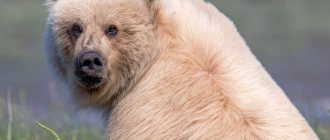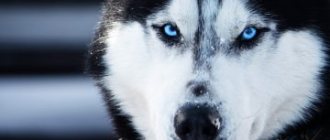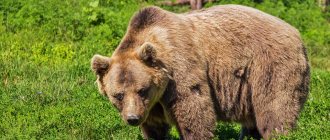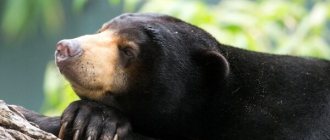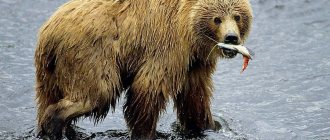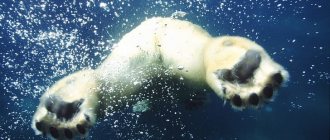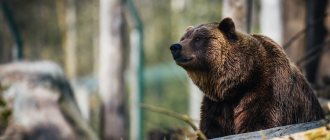The polar bear is the world's largest terrestrial carnivore, living in the Arctic: in the remote northern regions of Greenland, Norway, Canada, and Russia.
And although northern bears traditionally look white, surprisingly, their fur lacks white pigment, in fact it is translucent, and its skin is black.
So why is the polar bear white? The answer to this question is provided by scientists' research into what the polar bear's fur is made of, as well as the study of optical phenomena that affect the color of this animal's fur. Interesting fact: The polar bear is the largest land predator on Earth. The length of the animal is about 3 meters, weight – up to 1 ton.
You won't immediately believe the color of a polar bear's skin.
The polar bear (other names for the polar bear: polar bear, northern bear, oshkuy, nanuk, umka, sea bear) is one of the leading predators on the planet, which is a member of the Bear family. The great polar bear is the epitome of strength. Location In this article you can see a photo and description of a polar bear, learn a lot of new things and interemoshomenokimonikimobimenomog
The main characteristics of polar bears. Habitat, feeding habits, reproduction, habitual way of life. Is the animal dangerous for humans?
Newborn cubs are very tiny
Despite the incredible size of polar bears, when they are fully grown, they start out incredibly small—about the size of an adult hamster, to be exact. Weighing about two kilograms, cubs are born blind, toothless and barely covered with enough fur to insulate them from the cold. But thanks to their mother's nutritious milk, which contains about 31% fat, the cubs are ready to play on the ice in no time.
Predators of the North Pole
The polar or polar bear is the largest carnivorous mammal that lives in it, it is called. It is the closest relative of the brown bear and belongs to the bear family. In nature, there are about fifteen species of polar bear, the total abdomen
You can meet these animals in the polar latitudes from Newfinland.
If you think about the natural zone in which polar bears live, you might be surprised: they are the only large predators in the Arctic, ideally adapted for normal existence in polar latitudes. For example, during snow storms they dig holes in the snowdrifts, lie down in them and never send the child away
Koalas are the original representatives of the living world of Australia 9466 4.81 1
The size and weight of these animals largely depend on their place of residence: the smallest animals according to the description live on Spitsbergen, while the largest ones live in the Bering Sea:
- The weight of males ranges from 400 to 680 kg, length - about three meters (large lions and tigers are not large);
- The weight of females ranges from 200 to 270 kg, length - about two meters.
According to the description, the polar bear differs from other representatives of its species by its greater weight, powerful sloping shoulders, flat head and longer neck.
There is fur on the soles of the paws, which allows the animal not to slip and freeze. A membrane is used between the toes, and the structure of the paws allows polar bears to swim granatite. Large curved claws are not only capable of holding even strong prey, but allow it to easily move across sliding ice and climb over blocks.
It is noteworthy that these animals are quite capable of reaching speeds of up to 10 km and without stopping the engine 160 stops. They are also very good divers and can stay underwater for about two minutes.
The polar bear does not freeze thanks to a thick, about 10 cm, layer of subcutaneous fat on the back, back of the body and hips, as well as very warm fur, which retains the heat generated. The predator's fur is very thick and dense; it not only reliably retains heat, but also protects the animal from getting wet, and its white color makes it possible to camouflage perfectly.
The teeth of polar bears are also noteworthy: in cross-section, they form annual circles of two caemen-bears. The tooth is tightly attached to the jaw, since the root of the teeth is connected to it by a layer of cement, the root of the teeth. At different times of the year, the layer grows differently and seems to consist of two parts: the winter layer is thinner than the summer layer, which is located above it, and the older animal, the smaller the distance between the rings.
Has anyone ever wondered what color the skin of a polar bear is? Many will say that she is also white. But they are wrong. This polar animal has black skin. It seems incredible. But it is precisely this coloring that allows the bear to survive in the conditions of the Far North.
Influence of optical phenomena
The polar bear's fur is translucent, but due to the properties of the protective hairs, which are involved in creating the optical effect, this animal's fur appears white. From an optical point of view, the reason why a polar bear appears white.
Interesting: Why don't dogs like cats? Reasons, photos and videos
Luminescence
Exposure to light causes a reaction known as luminescence - - This occurs whenever a beam of light comes into contact with an animal's fur.
Luminescence is accelerated by light-scattering parts in the hairs, which destroy the light beam. — Light scattering particles are found both on the inner surface of the hairs and on the outside. The scattering of light leads to the appearance of more color and its further inomikonogonomiconikonomenok Thus, the translucent fur of the bear reflects sunlight. This is the reason why polar bears are especially bright in direct sunlight. The brighter the lighting, the more light is reflected by the polar bear's translucent fur.
Salt particles
Sea salt particles Polar bears spend a lot of time in water, which explains the Latin name for these members of the bear family, ursus maritimus, which means “sea bear.” Polar bears collect salt particles while swimming or staying near salty snouts. Salt particles along the rough surface of the wool also act as light scattering particles, which increase light rays and enhance luminescence.
Ultraviolet light
Ultraviolet light in the optical spectrum When the sun shines on a polar bear, ultraviolet light along the protective hairs travels down to their base and penetrates the dark skin of the animal. When ultraviolet light hits the skin, it causes a whitish color due to fluorescence (the ability to absorb energy in the form of cold light radiation). Fluorescence is a type of luminescence. Thus, ultraviolet radiation also causes the bear's fur to turn white.
.
Keratin
Keratin is a common natural protein found in skin, nails and hair. Similar to humans, the hairs of bear creatures contain keratin. The protein molecules of keratin give off a whitish color.
Interesting: Polar bears - movement: description, photos and videos
Has anyone ever wondered what color the skin of a polar bear is? Many will say that she is also white. But they are wrong. This polar animal has black skin. It seems incredible. But it is precisely this coloring that allows the bear to survive in the conditions of the Far North.
Why are polar bears black?
Where ice and snow prevail, it is very important to always remain invisible. Of course, polar bears have no natural methods. They do not need protective camouflage from predators.
At the same time, bears are fierce hunters. They kill seals and seals to maintain their existence. It is extremely easy for bears to get close to their prey without being noticed. For this reason, in the process of evolution, they developed white wool, which blends well. But her hairs themselves are hollow. They perfectly transmit sunlight to the body of the animal.
And here a logical question arises: what color is the skin of a polar bear? It is black because it can absorb maximum heat emitted by the sun. This allows the animal to warm up and quickly dry the water-soaked fur. Proof that these predators actually have a black pigment in their skin coloring is amazing. They just demonstrate the color of a polar bear’s skin. These are the most noticeable parts of his body that give away his disguise.
The polar bear (Ursus maritimus) is a large species of bear that inhabits the ice fields of the Arctic Ocean.
A little physics
Everyone knows from school that white reflects maximum sunlight, and black absorbs them. Therefore, the ground warms up faster than the snow cover. For the same reason, dark clothes make it much hotter in summer.
And one more point regarding polar bears. In a transparent medium, light rays can travel a fairly long distance. This principle is used in the modern world to create optical fiber, which transmits information much faster than metal conductors. How does this relate to the coat and skin color of a polar bear?
Nutrition
The polar bear must be supplied regularly to eat well and maintain a diet of body fat that maintains body heat. The skin and subcutaneous fat of ringed seals makes up the bulk of the diet. The diet largely consists of ringed seals (seals) and bearded seals (sea hares). Although body fat is very important for a bear, polar bears can also feed on birds, berries, fish, deer (especially in the summer months), as well as walruses and even whales. Carcasses from large marine mammals are a regular source of food for polar bears. As is known, bears of this species can tear apart the underground burrows of seals and hunt their hysheneten. Eating seals is vital to the polar bear's survival. They have a layer of fat up to 10 centimeters. During the short Arctic summer, polar bears are forced to travel further and further north as they retreat and the possibility of adequate nutrition disappears.
The polar bear is the largest representative of the bear family. Polar bears are not supposed to be aggressive towards people, but there are exceptions.
Who eats penguins?
Leopard seals (Hydrurga leptonyx), Antarctic fur seals (Arctocephalus), Australian sea lions (Neophoca cinerea) and New Zealand sea lions (Phocarctos hookeri), as well as killer whales (Orcinus orca) and sharks (Selachii) hunt penguins at sea, especially the above-mentioned species seals often patrol the shallow waters near...
Interesting materials:
How many liters are in the bathroom? How long does Logic hold a charge? How many horses are in the ambulance? How many spoons of coffee per 300 ml Turk? How many moons do the planets have? How long can you hide friends on VK? How much MB does Discord use? How much honey is in a kilogram? How many megabits do you need for a smart TV? How many months does military training take?
Description and photo of a polar bear
The polar bear is the largest representative of the bear family. As an independent species, it was first described in 1774 by K. Phipps, receiving the Latin name Ursus maritimus, which means “sea bear.”
Polar bears evolved from brown bears during the late Pleistocene period, with the oldest record being 100 years old and found at the Royal Botanic Gardens in London.
Body length of males is 2-2.5 m, females - 1.8-2 m; the weight of males is 400-600 kg (especially well-fed individuals can weigh a ton), females - 200-350 kg.
In the photo, a polar bear is jumping from an ice floe. Despite their massive body, these animals are surprisingly agile. If necessary, they can swim for several hours.
The structural features are associated with living conditions in a harsh climate. The body of the polar predator is stocky; They do not have the raised withers characteristic of brown bears. The polar one is narrower and longer, the polar one is narrower and longer. The animal's ears are small and rounded.
— Their fur is naturally white; it serves as an ideal camouflage for the beast. However, fur often acquires a yellowish tint due to pollution and fat oxidation, especially. It is interesting that while the coat is white, the animal’s skin is dark.
Interesting fact: despite the fact that polar and brown bears are very different in appearance, they are close relatives and can interbreed in captivity. A hybrid of such a cross is called a grolar or pizzly.
Discover 10 amazing facts about the polar bear that will teach you a lot about this amazing animal from the land of permafrost.
Few people know that the fat layer of a polar bear reaches 100 millimeters and sometimes the composition of the polar bear is fatty. This helps him overcome serious distances in icy water.
It happens that a bear swims tens of kilometers and does not feel any discomfort at all.
3 Blue tongue
Most people don't even realize that a polar bear's tongue is blue at times. This is due to this large number of pigments, as well as the high blood supply to the organ.
4 If you live in the Arctic, have time to turn around!
Despite their external clumsiness and large size, the Arctic giants are quite deftly
With a seemingly leisurely gait, they can walk up to 6 kilometers in one hour. The running speed will also surprise you: it reaches 45 km/h.
The king of the Arctic swims quickly and can swim about 10 kilometers in 60 minutes.
5 Polar bears are excellent hunters
Polar bears demonstrate their unique intelligence while hunting. The hunter's black nose unmasks him, so the bear covers it with his paws.
A characteristic feature of this animal is patience: sometimes it takes hours to
6 You can't hibernate in the Arctic
An important difference from its brown counterparts is that it is the only representative of the bear family that is active throughout the year and does not sleep in dens.
7 Size matters
The Arctic giant has a very impressive size. The weight of an adult animal reaches 750 kilograms, and its height is about 3 meters. There is no larger predator in the world.
.
8 Clean
Polar bears pay great attention to cleanliness. It would seem that in places where there is only water and ice, it is quite difficult to disturb the external cleanliness. All the same, after each meal, the northern hunter carefully licks his fur ikotekikikikinek.
9 Smell is better than a dog's
Polar bears also have an amazing sense of smell.
They are able to sense seals at a very long distance of up to 30 kilometers. If a seal breathed in the hole and swam away, then the predator is able to sense this place more than 500 mm wide.
